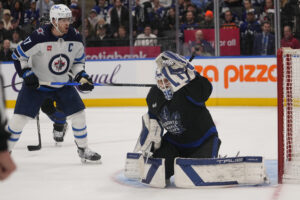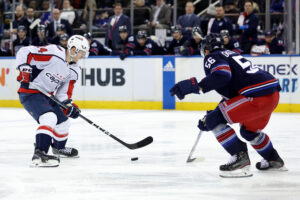Over the last several months, I have been crunching numbers, trying to solve the many questions of NHL prospects development. With that, we here at Last Word On Hockey will be starting a new series on how to properly develop prospects from all different spots throughout the draft.
Developing NHL Prospects: First Overall Picks… and Jack Eichel
From 2005-2015, there have been 24 draft picks used on forwards from North American junior teams in the top-three. The focus was directly on North American prospects for the sake of comparing stats. I separated those 24 forwards from the rest of the top-three picks in that span. Then, I looked at their DY-1 stats, the season before they get drafted, and their DY stats. I averaged out their points per game in their DY-1, DY and beyond, if necessary, and color-coded them. The four sections were “well-above average,” “above average,” “below average” and “well-below average.”
Based on the sections they landed on before they played 15 or more games in an NHL season, they were separated into categories. The categories were “Forwards deemed NHL Ready,” “Forwards nearly NHL Ready,” “Slightly Rushed,” “Rushed,” “Forced,” “Teams were Patient,” and “Teams were way too patient.” There were five forwards who landed in the near NHL ready grouping and were called up immediately. Those players were Steven Stamkos, John Tavares, Taylor Hall, Nathan MacKinnon, and Jack Eichel. Four of the five players posted one well-above average and one above average junior season, while one (MacKinnon) posted back-to-back above average seasons. In this piece, we will look at Taylor Hall, Nathan MacKinnon, and Jack Eichel. Click here for Stamkos and Tavares.
Player Development of Taylor Hall
Taylor Hall recorded a well-above average DY-1 season in the OHL, recording a 1.429 points per game mark. He followed that up with a strong step forward, recording 1.86 points per game. Though relative to other top NHL prospects and top-three picks, it was not considered well-above average, and was deemed above average. Despite not being considered NHL-ready in the scope of this project, he was called up to the Edmonton Oilers directly following the draft.
How was Hall used?
In Hall’s rookie season, he played in 65 games, averaging 18:13 time on ice per game. In those games, he posted 22 goals and 20 assists for 42 points. Hall’s advanced stats were better than both the aforementioned players in their respective rookie years, except for his EVD. He posted a 6.1 EVO and a -4.2 EVD, only worse than Stamkos to this point. His WAR was up at 1, while his GAR was at 5.8.
Sophomore Slump?
Despite his stats being great as a rookie, Hall was not given a raise at all in playing time. In fact, playing just 61 games in year two, he averaged the exact same ice time as year one, 18:13 per game. He put up 27 goals and 26 assists for 53 points in that span. Hall’s EVO went up to 6.9, while his EVD improved drastically, but still being below replacement level, at -0.1. His WAR rose significantly, recording a 2.3 score in that metric. His GAR also rose to 13.2.
After improving quite clearly at every aspect and being a fairly large contributor, Edmonton stepped backwards. Hall was reduced to just 45 NHL games due to the lock-out. He was sent down to the AHL for 26 games, as well. He averaged 18:37 minutes of ice time per game in his third year, but that is not a big raise. Playing in the AHL also was not the right move by the Oilers.
Despite this, Hall scored 16 goals and 34 assists for 50 points in those 45 games. His EVO score continued its slow rise, as he scored an 8.3 in this metric. Hall’s EVD dropped a bit, however, as he registered a -1.4 mark in year three. His WAR also dropped down to a 1.7 mark and, as expected, his GAR also dropped to a 9.2 mark. These numbers are obviously a step back, but he by no means should have played in the minors at any point. Shawn Horcoff averaged just under 17 minutes a game for crying out loud! Hall should have averaged more time or simply should not have played in the minors. At the very least, loan him to Europe, where most other NHLers went.
Player Development of Nathan MacKinnon
MacKinnon was drafted by the Colorado Avalanche out of the QMJHL. In his DY-1 season, MacKinnon posted a point per game mark of 1.345, landing in the above average category. He followed up his impressive DY-1 season with an improved 1.705 mark in his DY. That also landed in the above average category, relative to all the other top 3 picks from 2005 to 2015. He immediately made the Avalanche roster out of the draft with those seasons.
How was MacKinnon used?
MacKinnon played all 82 NHL games in his rookie season with the Avalanche. He averaged a solid 17:21 time on ice per game. With that role as a rookie, MacKinnon recorded 24 goals and 39 assists for 63 points. Those are solid numbers, especially for a rookie. He backed that up with a 9.1 EVO score and a -2.7 EVD score. Additionally, he had a ridiculous 2.9 WAR and 15.3 GAR, blowing every other player’s advanced stats listed above him.
Following up that excellent rookie season, he played just 64 games. Not only did he miss time, but he also averaged slightly less time on ice, playing an average of 17:03 per game. Why wouldn’t they give this young kid more ice time, especially after the dominant numbers he put up? 35 year old Alex Tanguay and 37 year old Jarome Iginla averaged more time than this young MacKinnon that season!
MacKinnon’s Sophomore Slump
That lack of a raise in terms of ice time, along with missing time, hurt his raw stats. He posted just 14 goals and 24 assists for 38 points. His EVO dropped to a 3.3 mark, while his EVD rose to a -1.7 score. His WAR dropped dramatically to a 0.7, and his GAR did the same, falling to a 3.4 score. The epitome of a sophomore slump and the misuse of their future cornerstone by the Avalanche are to blame.
In his third year, MacKinnon played in 72 games, 8 more than the prior season. He averaged 18:52 time on ice per game, a large raise, finally! With that, MacKinnon posted 21 goals and 31 assists for 52 points. His EVO rose to a nice 6.9 score, while his EVD continued it’s steady incline, recording a -1.6 score. His WAR jumped back up to a very good 2.3 mark, while his GAR rose back up as well, recording an 11.9 mark in that stat.
Player Development of Jack Eichel
Jack Eichel joins this list of phenomenal NHL prospects largely thanks to an amazing DY-1 season, with a 1.642 point per game rate with the USDP team. That rate was considered well above average in comparison to other top 3 picks. In the NCAA, he produced an above average mark of 1.775 points per game. Those stats led to him becoming the potential face of the Buffalo Sabres for years to come.
How was Eichel Used?
Eichel played 81 of 82 games in his first NHL season, averaging 19:07 of ice time per game. In that role, he produced 24 goals and 32 assists for 56 points. On top of that, Eichel posted a 5.9 EVO, -3.9 EVD, 1.4 WAR, and a 7.4 GAR. Comparatively speaking, looking at the aforementioned players, Eichel placed about middle of the pack in terms of analytics.
In his second season, Eichel had his total games played dip to just 61, while his role in terms of ice time per game grew to 19:55. He scored 24 goals and 33 assists, for 57 points, despite only playing 61 games. A slight raise despite missed time, following a decent rookie season. His EVO rose slightly, as did his EVD, scoring a 6 and a -2.9 score in those categories, respectively. His WAR and GAR also steadily rose, scoring a 1.6 and 8.3 score in those metrics, respectively. So, a slight raise to his role led to a slight raise to his overall game.
In his third season, Eichel again missed time, playing 67 games. His role rose yet again, as he averaged 20:09 time on ice per game, another slight raise. He posted 25 goals and 39 assists for 64 points in that role. His EVO score stayed the same at 6, but every category saw a jump. His EVD rose to a -1.4, his WAR rose to 2.3 and his GAR rose to a 12.
NHL Prospects Development For These Star Players
As mentioned in the last NHL prospects development article, it’s very difficult to whiff on a top 3 pick. However, each of the 3 aforementioned players had varying levels of success. After their first three years, Eichel registered the biggest role, followed by MacKinnon and Hall. Analytically in each of their first three years, Hall was the best, followed by MacKinnon and Eichel.
In their careers, Hall has the highest EVO per 60 score, followed by MacKinnon and Eichel. The highest EVD/60 also belongs to Hall, followed by MacKinnon and Eichel finishing in that order. MacKinnon has the highest GAR/60 and WAR/60, as Hall and Eichel finished behind him. However, as mentioned earlier, each player has had varying levels of success. In what way did they vary?
Career Variations
MacKinnon was a bit slow to start his career, before breaking out. Same with Eichel, to a degree. Hall, on the other hand, had a massive breakout year, which looks like a massive outlier. Removing the first few slow years for Eichel and MacKinnon, plus removing Hall’s outlier season, here’s how they rank.
Removing the Outliers
After removing the aforementioned outliers, MacKinnon finished first in all four of the analytics used, and Eichel finished second in all four. Meanwhile Hall finished last in all four categories. While Eichel had the biggest role in his first three seasons, MacKinnon did not trail him by much. Hall suffered the smallest role, and his performance has reflected that.
MacKinnon not only received a role very close to Eichel in his first three years, but following those three years, he has been surrounded by incredible talent. Mikko Rantanen and Gabriel Landeskog, to name a couple, have been consistent linemates of MacKinnons, and they’re both extremely talented. Meanwhile, Eichel has had a rotating door of NHL prospects and some veterans, including Casey Mittelstadt, Sam Reinhart, Jeff Skinner and Victor Olofsson. None of those players equal Rantanen or Landeskog.
Taylor Hall was never surrounded by top-tier talent either, but you can argue he has had better linemates than Eichel. In Edmonton, he had Jordan Eberle, Ryan Nugent-Hopkins and a very young Leon Draisaitl. With the Devils, he had Nico Hischier and Kyle Palmieri. Finally, in this past season with the Coyotes, he was often lined up alongside of Clayton Keller and Phil Kessel. So, with the idea of their roles being different in the early portions of their career, along with how their teams built around them, a pattern is developed.
Main Photo:






